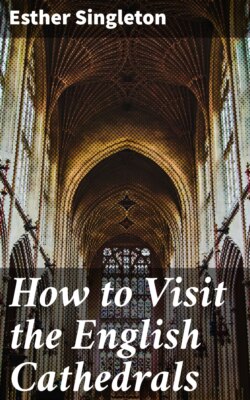Читать книгу How to Visit the English Cathedrals - Singleton Esther - Страница 14
На сайте Литреса книга снята с продажи.
WINCHESTER
ОглавлениеTable of Contents
Dedication: The Holy and Indivisible Trinity. Formerly the Church of a Benedictine Monastery.
Special features: Norman Nave; Tower; West Window; Choir-stalls; Font; Reredos.
Winchester is the largest cathedral in England and affords good examples of every style from pure Norman to early Renaissance. It is the fifth cathedral that has occupied this site, for tradition says that a British church was founded here by Lucius, King of the Britons.
This first church was destroyed in 266 and the clergy martyred during the persecutions of the Christians by Diocletian. The second church, erected under Constantine, was in 515 transformed by Cerdic, founder of the Kingdom of Wessex, into a Temple of Dagon, in which he was crowned in 519 and buried in 534. Cerdic’s great grandson, Kynegils, converted by St. Birinus, the first of Saxon bishops, began the third church which his son, Kenwalk, completed in 648. Kenwalk’s buildings were, in their turn, enlarged and repaired by Swithun, a prior of the Benedictine monastery established here. Swithun, who became Bishop of Winchester and tutor to King Alfred and Ethelwold, was, according to the chroniclers, “a diligent builder of churches in places where there were none before, and a repairer of those that had been destroyed or ruined.” When he died in 862, he was buried, according to his own desire, in the churchyard of Winchester, where “passersby might tread on his grave, and where the rain from the eaves might fall on it.”
When this third church was destroyed by the Danes in 867, portions were restored by Alfred the Great, St. Ethelwold and St. Alphege. St. Ethelwold removed the body of St. Swithun to the golden shrine within the cathedral, now dedicated to St. Swithun, St. Peter and St. Paul; but the Translation being delayed by rain, gave the saint reputation as a weather prophet. Hence the weather on the anniversary (July 15) is foretold by the old rhyme:
“St. Swithun’s Day, if thou dost rain,
For forty days it will remain;
St. Swithun’s Day, if thou be fair,
Forty days ’twill rain na mair.”
One of the features of St. Ethelwold’s cathedral was a magnificent “pair of organs,” of tremendous size and power, with twelve bellows above and fourteen below and seventy strong men as blowers to fill the four hundred pipes. Below, at two keyboards, sat two brethren in “unity of spirit.”
Ethelwold was buried in the southern crypt.
This Saxon church was succeeded by the present cathedral, begun in 1079, by Walkelyn, the first Norman bishop.
Walkelyn was of noble birth and related to William Rufus, who granted him license to search for stone in the Isle of Wight and as much wood from the forest of Hanepinges (on the Alresford road) as his carpenters could take in four days and nights. The wily Bishop collected a large force of men and within the assigned time cut down the whole forest. The King was furious. The new Cathedral was finished in 1093, having been rebuilt by Walkelyn, from the west front to the great tower, including the transepts. He also removed, and with great pomp, St. Swithun’s shrine from the old altar to the new one. Walkelyn died in 1098 and was buried in the nave.
Bishop Lucy, Bishop William of Edington and William of Wykeham are the next three great architects of Winchester.
“It was Bishop Edington who commenced the alteration of Winchester Cathedral into the Perpendicular style; he died in 1366, and the work was continued by William of Wykeham, who mentions in his will that Edington had finished the west end, with two windows on the north side and one on the south: the change in the character of the work is very distinctly marked. Bishop Edington’s work at Winchester was executed at a later period than that at Edington, and, as might be expected, the new idea is more fully developed; but on a comparison between the west window of Winchester and the east window of Edington, it will at once be seen that the principle of construction is the same; there is a central division carried up to the head of the window, and sub-arches springing from each side: it may be observed that whenever this arrangement of the sub-arches occurs in Decorated work, it is a sign that the work is late in the style. Before the death of Bishop Edington the great principles of the Perpendicular Style were fully established. These chiefly consist of the Perpendicular lines through the head of the window, and in covering the surface of the wall with panelling of the same kind. These features are as distinctly marked at Winchester as in any subsequent building, or as they well could be.”—(J. H. P.)
In the eastern part of the Crypt there is ancient masonry undoubtedly belonging to the time of St. Ethelwold; then we find above it the massive Norman work of Bishop Walkelyn; then, to the east, the graceful Early English of Bishop Lucy; along the nave, the Perpendicular columns of Bishop Edington and William of Wykeham, on which rests the exquisite groined roof. Above this roof the great rough-hewn beams cut from the King’s forest by Walkelyn more than eight hundred years ago can still be seen and in a perfect state of soundness.
